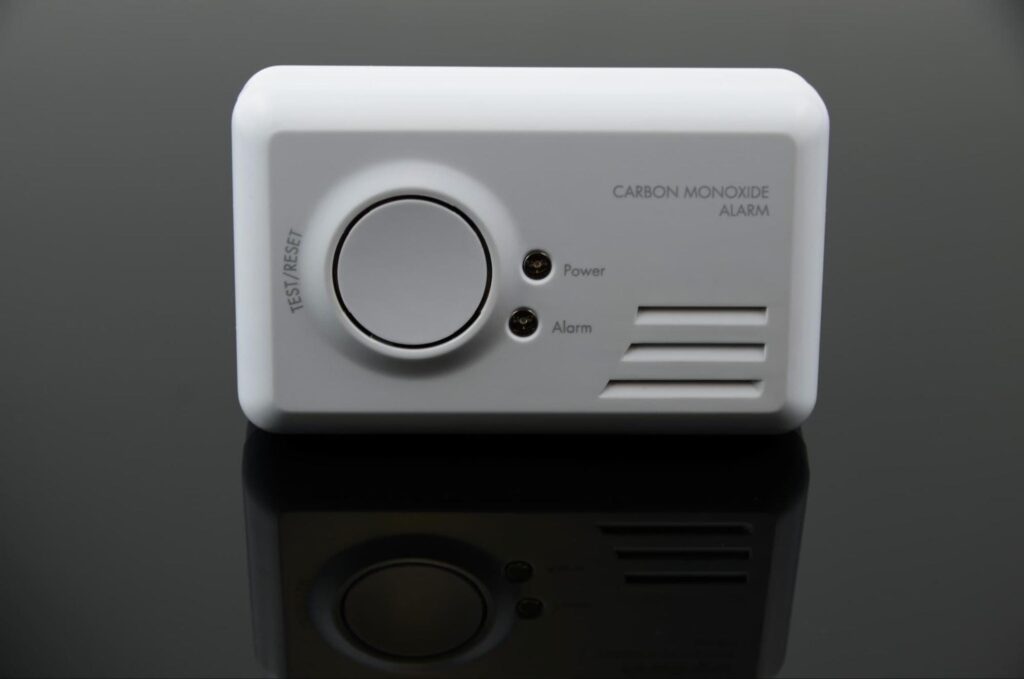Gas leaks of any kind in your property can be very serious, so if you think you have one, act immediately by turning off your gas supply, vacating the property and contacting an emergency Gas Safe registered engineer.
Below, we take a look at carbon monoxide leaks and what you should do if you have one.
Can a boiler leak carbon monoxide?
Put simply, yes.
For context, gas appliances like boilers and hobs work by burning a fuel (natural gas) to create heat energy. This is then used to cook your food or heat the water in your radiators for central heating.
Normally, burning a fuel like gas results in the creation of carbon dioxide – a compound that has two oxygen atoms in every molecule. But when there isn’t enough oxygen available during the combustion process, some of the molecules created end up with just one oxygen molecule apiece – making carbon monoxide instead.
Why is that a problem? Well, carbon monoxide is a noxious gas that can have unpleasant and even life-threatening effects if you breathe in too much of it. It lowers the amount of oxygen reaching your brain, leading to symptoms such as:
- Headaches
- Confusion
- Nausea
- Shortness of breath
- Loss of consciousness.
Unfortunately, carbon monoxide is virtually undetectable without the use of a special sensor – you can’t see it, smell it or taste it. This means it can be easy for carbon monoxide to build up and cause symptoms before you even realise there’s a leak.
Boilers are installed with a flue that is designed to direct undesirable gases like carbon monoxide out of your home so they can’t harm you. However, faults with your boiler can cause this to fail, leading to a carbon monoxide leak. This is one reason why it’s important to ensure your boiler is serviced for faults regularly.
What to do if you suspect your boiler is leaking carbon monoxide
As mentioned, carbon monoxide is almost impossible to identify without a sensor – but there are signs you can look for. For example:
- Your boiler struggles to stay alight
- There is more condensation than usual on your windows
- Dark patches are forming around your gas appliances.
For something a little more reliable, you should install a carbon monoxide detector in any and all rooms that have a gas appliance – or any other appliance that burns a fuel, such as a wood burning stove.
A carbon monoxide detector can often identify an excess of carbon monoxide in the air before you notice medical symptoms or the physical signs outlined above. They’re cheap to buy and easy to install – and they might just save you from significant health problems caused by a gas leak.
Legally speaking, in England and Wales it’s required to have a carbon monoxide detector in all rooms that are lived in and have a solid fuel burning appliance – e.g. a wood burning stove. However, we strongly recommend installing a carbon monoxide detector anywhere that has gas appliances as well – it’s better to be safe than sorry.
So, in the event that your carbon monoxide detector goes off, or you notice the aforementioned signs and symptoms, what should you do? There’s no need to panic, but swift action is important.
First, turn off your gas supply at the mains and get everyone out of the property into the fresh air. Then, call a Gas Safe registered engineer to inspect and repair your boiler or other gas appliance.
Can a boiler leak carbon monoxide when switched off?
Since the production of carbon monoxide stems from incomplete combustion, then it can’t be released by your boiler if it’s turned off and thus not burning fuel. However, be aware that your boiler isn’t the only potential source of a carbon monoxide leak.
That’s why you should turn off your gas supply at the mains – that way, any and all leaky gas appliances should stop producing carbon monoxide. It’s still vital to leave the property, though, because the gas will have built up inside and can still cause symptoms even if no more is being produced.
What about opening windows? Well, it’s true that allowing the fresh air in is better than doing nothing at all, as it will help to supply your brain with oxygen. However, lots of ventilation is needed in order to remove the carbon monoxide from your property, and that takes time – during which, you could still suffer the effects of carbon monoxide poisoning.
Carbon monoxide leaks can cause severe health problems and could even result in death if you don’t take action, but fortunately, the steps are easy to remember.
- Turn off the mains gas supply.
- Get everyone outside.
- Call a Gas Safe registered engineer.
Looking after your gas and heating appliances is the best way to protect yourself and your loved ones from the impacts of carbon monoxide poisoning, so keep a regular servicing schedule and get any issues fixed as soon as possible. And remember, carbon monoxide detectors can save your life.



